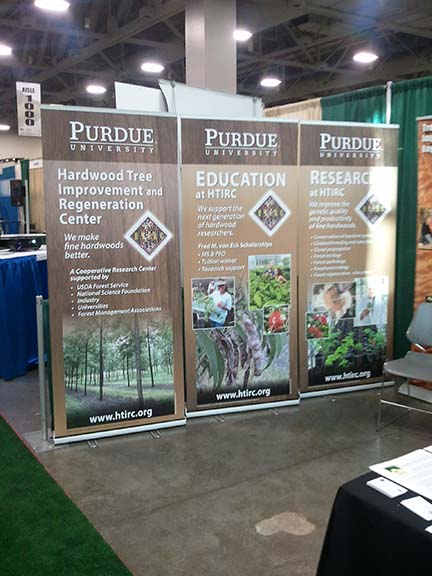HTIRC E-NEWSLETTER – December 2014
Volume 7 Issue 2
Articles in this issue:
- Can We Learn from the Mountain Pine Beetle Outbreak in the Northwest?
- Geosmithia morbida, the Causal Agent of Thousand Cankers Disease, Found in Indiana
- Using Expanding Group Shelterwoods to Increase Oak Recruitment
- Bumper Seed Crops Represent a Tree Regeneration Opportunity
- Forgey Farm Field Day a Big Success
- HTIRC Hosts 2nd Restoring Forests Congress
- HTIRC Participates in the Largest Forestry Conference in Decades
- HTIRC Partners Support Research with Matching Funds
- Purdue Forestry Farm Named for Former Senator Richard G. Lugar
Welcome to this issue of the Hardwood Tree Improvement and Regeneration Center E-newsletter. The HTIRC is committed to enhancing the productivity and quality of Central Hardwood Region trees and forests for the economic and environmental benefits they provide. Scientists at the HTIRC are using conventional tree improvement breeding as well as molecular and genetic technologies to improve the wood quality, growth characteristics, and insect and disease resistance of trees like black walnut, black cherry, red and white oaks, butternut and American chestnut. Research in tissue culture, tree nursery practices, tree plantation establishment and management, and Central Hardwoods silvicultural systems is aimed at increasing the regeneration success rate for high quality hardwood trees and forests. Some interesting and unusual research areas include examining the potential for propagating trees with “figured” wood: birds-eye maple or curly walnut; and breeding trees that will be an economical source of bio-fuels. Twice per year we will attempt to provide interesting and useful information on Central Hardwood trees and forests, as well as sources for additional information and assistance. Please pass this newsletter along to others who may enjoy or benefit from the information provided. If you would like a closer look at the HTIRC, please visit our web site at:http://www.htirc.org
Can We Learn from the Mountain Pine Beetle Outbreak in the Northwest?
By Shaneka Lawson, Plant Physiologist and Matt Ginzel, Forest Entomologist
The genome of the mountain pine beetle (MPB), Dendroctonus ponderosae, was recently published by researchers at the University of British Columbia, and represents a huge step forward in our understanding of how this destructive beetle survives and even flourishes under changing climates. The MPB has begun to move northward and eastward at an alarming rate. It was estimated that greater than 18 million hectares of pine in British Columbia are infested and dying. Several million hectares of pine in the US have been infested and are also dying.
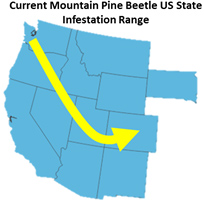
These data reveal that individual beetles are highly mutable in a number of detoxification genes that may allow them to thwart defensive compounds produced beneath the bark of host trees. In addition, genes encoding degradation enzymes that allow beetles to break down cellular material to absorb nutrients were also isolated and amplified from the genome. Interestingly, a key bacterial gene that functions to break down plant sugars has also been incorporated into the MPB genome and may enable the beetles to better digest woody tissue.
Earlier this year, researchers also discovered genetic markers that may influence the adaptation response of MPB. These markers may be responsible for honing the cellular and metabolic functions of the beetle to withstand previously unfavorable climates and allow for its geographic range expansion.
Could genome information gleaned from MPB be used to understand how some of the invasive beetles threatening Indiana hardwoods persist despite concentrated efforts to manage them? Are there existing similarities between natural conditions that limit range expansion of MTB and management tactics for invasive beetles in the east and Midwest?
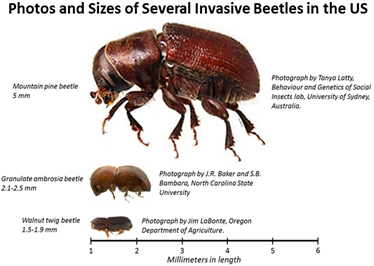 The invasive the walnut twig beetle (WTB) (Pityophthorus juglandis) and the granulate ambrosia beetle (GAB) (Xylosandrus crassiusculus) are two of the most destructive beetle pests. Could the adaptive genes found in the MPB genome serve similar functions in these beetles as well? At present, no published research data has addressed these theories but the efforts by MPB researchers are being closely followed as keys to the MPB spread are being discovered.
The invasive the walnut twig beetle (WTB) (Pityophthorus juglandis) and the granulate ambrosia beetle (GAB) (Xylosandrus crassiusculus) are two of the most destructive beetle pests. Could the adaptive genes found in the MPB genome serve similar functions in these beetles as well? At present, no published research data has addressed these theories but the efforts by MPB researchers are being closely followed as keys to the MPB spread are being discovered.
No in-depth genome information for either the WTB or GAB has been released yet however recent research publications have investigated the fungal symbionts associated with these pests. The fungus Geosmithia morbida; the causative agent of Thousand Cancers Disease (TCD), is vectored by WTB, a sap stain fungus, Bothryodiplodia and an unidentified Fusarium spp. by GAB, and the blue stain fungus Grosmannia clavigera by MPB. Concentrated efforts to uncover additional information about interactions within these symbiotic relationships may uncover mechanisms available for exploitation during the development of new eradication methods.
Referenced Information:
S.M. Alamouti, S. Haridas, N. Feau, G. Robertson, J. Bohlmann, Breuil, C. (2014) Comparative Genomics of the Pine Pathogens and Beetle Symbionts in the Genus Grosmannia. Mol Biol Evol, 2014; Online first. doi: 10.1093/molbev/msu102
C. I. Keeling, M. M. Yuen, N. Y. Liao, T. R. Docking, S. K. Chan, G. A. Taylor, D. L. Palmquist, et al. Draft genome of the mountain pine beetle, (Dendroctonus ponderosae) Hopkins, a major forest pest. Genome Biology, 2013; 14 (3): R27. doi: 10.1186/gb-2013-14-3-r27
J. K. Janes, Y. Li, C. I. Keeling, M. M. Yuen, C. K. Boone, J. E. Cooke, J. Bohlmann, et al. How the mountain pine beetle (Dendroctonus ponderosae) breached the Canadian Rocky Mountains. Molecular Biology and Evolution, 2014; DOI: 10.1093/molbev/msu135
http://spfnic.fs.fed.us/exfor/data/pestreports.cfm?pestidval=149&langdisplay=
Geosmithia morbida, the Causal Agent
of Thousand Cankers Disease, Found in Indiana
By Matt Ginzel, Forest Entomologist and
Jennifer Juzwik, Forest Pathologist – U.S. Forest Service, Northern Research Station
Thousand Cankers Disease is caused by a fungus (Geosmithia morbida) vectored by a bark beetle, the walnut twig beetle (WTB), Pityophthorus juglandis (Coleoptera: Curculionidae: Scolytinae). This pest complex that has caused the widespread death of walnut trees (Juglans sp.) throughout the West and has recently been detected within the native range of black walnut including parts of Tennessee, Virginia, Pennsylvania, North Carolina and Ohio. Most recently, G. morbida has been recovered from black walnut in Brown Co., Indiana. In an attempt to protect the black walnut resource from TCD, many states in the North Central Hardwoods Region have issued an external quarantine prohibiting the interstate transportation of black walnut from affected areas.
Geosmithia morbida is a weak plant pathogen and requires an insect vector to become established. It also appears that large-scale attacks by the beetle are necessary for the pathogen to kill its hosts. In fact, trees often succumb to the disease only after thousands of beetles have colonized them. In the early stages of the disease, there are few outward signs of infection apart from the small entrance holes made as colonizing beetles bore through the bark. At this stage, small cankers develop around galleries of the colonizing beetles, and the fungus is often restricted to the cambium, but as the disease progresses, cankers expand into the phloem and outer bark (see Fig. 1). In the more advanced stages, cankers become more diffuse, causing the tissues to become dark-colored and macerated. Trees infected with TCD show signs of general decline including yellowing, wilted or tufted leaves and crown dieback as a result of the slow starvation effect of the fungus. Affected trees typically die within three years after visual symptoms of the disease first appear in the tree crown.
Detection efforts for TCD in the eastern U.S. primarily rely on visual surveys of symptomatic trees and trapping for WTB using a commercially available pheromone lure. In 2011, the U.S. Forest Service, in cooperation with scientists from the University of Missouri and Purdue University, conducted a trap tree survey in Missouri and Indiana. The lower main stems of four black walnuts at 12 locations in Missouri and 15 sites throughout Indiana were girdled in late May or early June. After three months, the trees were felled and insects were reared from portions of the main stem and branches of the crown. After identifying all bark and ambrosia beetles and weevils reared from these tree sections, subsets of individuals from each of six predominant insect taxa were assayed for G. morbida.
No WTB were recovered from Indiana or Missouri. However, 435 adults of the weevil Stenomimus pallidus (Coleoptera: Curculionidae: Cossoninae; Fig. 2) were obtained from main stem samples from 12 sites in Indiana. The causal agent of TCD, G. morbida, was recovered from three individual S. pallidus that emerged from two trees growing in a black walnut plantation in the Yellowwood State Forest in Brown Co., Indiana. The fungus was not detected on any other wood-boring beetles reared from this site or on any beetles from other sites in Indiana. This is the first report of G. morbida from Indiana, and the first report of the fungus from an insect other than P. juglandis. Nevertheless, the low frequency of occurrence of G. morbida on S. pallidus suggests at least a rather loose and unspecific relationship between the fungus and this beetle. Moreover, the low population density of S. pallidus suggests that it may not be capable of vectoring enough of the pathogen to adversely affect tree health.
In response to this find, the DNR Division of Entomology & Plant Pathology, DNR Division of Forestry, U.S. Forest Service and Purdue University conducted additional studies in the plantation this summer to better understand the disease and potential insect vectors. Surveillance for WTB and G. morbida was also intensified in Brown County and in counties bordering Butler Co., Ohio, where TCD has been recently detected. Also, forest landowners should NOT harvest their black walnut trees as a result of this detection. Rather, if you notice a suspicious decline in black walnut trees or otherwise suspect an infestation of TCD, call the DNR toll-free at 1-866-NO EXOTIC (1-866-663-9684). If approached by someone offering to remove black walnut trees because of the disease, notify a DNR district forester or other professional forester to have the tree evaluated.
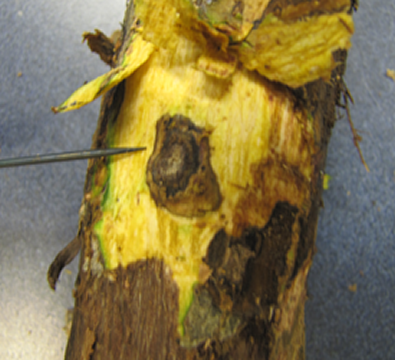
Figure 1: Canker caused by Geosmithia morbida on black walnut. (Photo by J. Juzwik)

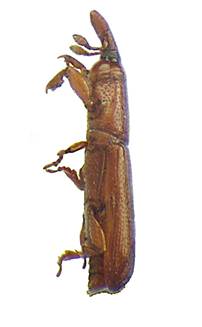
Figure 2: The weevil species, Stenomimus pallidus (Boheman) from
which G. morbida was recovered. Length: 1.5 mm.
(Photos kindly provided by J. C. Ciegler, West Columbia, SC).
Using Expanding Group Shelterwoods to Increase Oak Recruitement
By Ethan Belair, Research Assistant and Mike Saunders, Ecology and Natural Resources
Eastern hardwood forests have undergone many changes over the last century. Many of these changes, including timber harvesting, increases in invasive species and deer browsing, and fire suppression, have reduced the dominance of oaks in these forests. To the untrained eye, it may seem that the oaks of Indiana are regenerating adequately, as there are still abundant seedlings in the understory. However, these small seedlings never develop into larger trees, resulting in poor canopy recruitment of oaks. In many eastern oak stands, recruitment is inhibited by a thick midstory of maple and beech trees (Figure 1). These shaded understory conditions are very different from the more open, sunlit conditions the current oak overstory regenerated and recruited in more than a century ago.
To improve oak recruitment, we initiated a project that uses a silvicultural system not often used in North America, the expanding group shelterwood (Figure 2). This silvicultural system is a variant of the femelschlag system, which is commonly used to successfully regenerate oak species in Germany. We use a 100-year rotation, with entries every 10 years during the first half of the rotation. At each entry, approximately 20% of the total area is harvested in small groups. Each group is roughly 2 dominant tree heights in diameter, resulting in canopy openings of 0.25 – 1.0 ac.
Our system begins in the first entry with a midstory removal treatment applied to only part of a mature oak stand (Figure 3). This non-commercial treatment fells all sub-canopy trees greater than 6 feet tall within the first two overstory harvest areas (Areas A and B, Figure 2). The initial group harvest (Area A) overlays this midstory removal. In successive entries, the group harvest is expanded to the area receiving the previous midstory removal (e.g., Area B during the second entry) and a “buffer” immediately surrounding this expanded group is treated with midstory removal (e.g., Area C during the second entry). This cycle repeats until the entire overstory has been removed at the end of the fifth entry. In addition to these harvests, we periodically utilize prescribed surface fires to favor the more fire-adapted oak species.
Each element of this system is intended to benefit oak seedlings. The initial midstory removal will increase light availability to understory seedlings. This increases growth rates of oak seedlings and enhances their ability to compete with faster growing, shade intolerant species, like tulip poplar, following group harvests. The small, group harvests create a light environment that will be too shady for tulip poplar to thrive, but light enough to allow oaks to outpace more tolerant competitions such as maple and beech (Figure 4). Periodic prescribed surface fires will apply a selective pressure against fire-sensitive species like maple, beech and tulip poplar, while encouraging growth of fire-tolerant oaks and hickories. Fire will also reduce midstory density in unharvested parts of the stand, expose mineral soil and kill undesirable trees that resprout following midstory removal. All of these effects will be beneficial to oak recruitment.
This silvicultural system has ecological benefits aside from potentially increasing oak recruitment. Group harvests result in a light gradient from the high light in the center of gaps to areas in the surrounding midstory removal that receive only slightly more sunlight than untreated matrix forest. While this primarily favors oak, it increases the diversity of tree species regenerating, with less tolerant hardwoods like black cherry in the gap center, and more tolerant white oak on gap edges and in the buffer. Group shelterwoods also results in a diversity of structure, with open gap areas and intact matrix forest in close proximity to one another. This can be beneficial to wildlife species that might require open areas for foraging and mature forest for nesting or hibernation in close proximity to one another. Increasing structural diversity should increase an ecosystem’s resilience to climate change, insect outbreaks and other disturbances as well.
Finally, the expanding group shelterwood system provides a variety of benefits to the small landowners, whether or not prescribed burning is part of the system. As an alternative to selection systems, this partial harvesting system still provides multiple income flows throughout the lifetime of a landowner. Group shelterwoods can be used on a variety of different property sizes, and can reduce overall cost of the oak recruitment process when landowners are able to remove the midstory themselves. Systems that utilize expanding group harvests lend themselves to the establishment of permanent skid trails, and can reduce compaction and erosion associated with heavy equipment. Perhaps most importantly to many small landowners, the retention of intact forest decreases the negative public perception associated with some even-aged techniques such as clearcutting. This allows landowners the benefit of timber related income without making them give up the benefits of hiking, hunting, or otherwise enjoying their woods.

Figure 1. Prior to treatment, this mature oak-hickory stand has a dense midstory of
shade tolerant beech, dogwood and maple saplings. This layer reduces light
availability in the understory and inhibits the growth of oak and hickory seedlings.

Figure 2. Conceptual diagram of the harvest areas (A – E) within an
expanding group shelterwood regeneration system. This system uses five
cutting cycles for regeneration harvests, resulting in a 20% area control for
the stand. Dashed black lines are one potential permanent skid trail layout.
Regeneration harvests will not occur in the last 50 years of the
rotation; only thinning and stand improvement will occur.
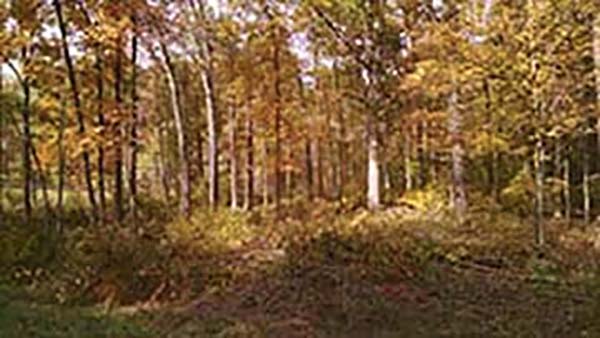
Figure 3. This oak-hickory stand has been treated with a midstory removal.
This treatment results in much higher understory light availability and
encourages growth of oak and hickory seedlings. The majority of the
felled midstory trees were beech, flowering dogwood and maple.

Figure 4. This oak sapling is benefitting from the increased light
availability at the edge of a group opening. Its chance of canopy recruitment is
much higher in this well-lit environment relative to closed canopy, mature forest.
Bumper Seed Crops Represent a Tree Regeneration Opportunity
By Lenny Farlee, Extension Forester
I’ve noticed several oak trees in the area are producing a bumper-crop of acorns. When many members of a species or group of species simultaneously produce a bumper-crop of seed, the phenomenon is called masting. The mechanisms controlling masting events are not completely understood, but the event has important implications for both plants and animals in the times and places it occurs. Masting events may overwhelm seed predators, providing an opportunity for trees to produce new regeneration. Wildlife populations that are directly and indirectly connected to seed predation can see population changes related to the abundance of food represented by the bumper seed crop. This population response is typically delayed since the improved nutrition of the seed feeders may result in increased survival and reproduction following the masting event. If there is a small or failed seed crop the season following this mast event, seed predators may suffer more than normal due to increased populations trying to survive on a small food resource. The predators and parasites that feed on these seed predators can experience similar population impacts.
Masting events also provide an opportunity for woodland managers to increase their chances of successfully regenerating tree species. Heavy seeded species like oaks, walnut, and hickories are a favorite target of seed predators like squirrels and other woodland rodents, deer, and turkey. In an average to poor seed production year, the vast majority of seed may be consumed by these and other seed predators, including weevils and other seed eating insects. In masting years, a huge pulse of seed can overwhelm the seed predators before they have a chance to increase population in response to the increased food base. This leaves excess seed that, given the correct conditions for germination and growth, can result in new tree regeneration. The growth characteristics of each species will determine what those conditions are. For oaks, some experiments done in southern Indiana indicate that raking or light disking to incorporate acorns into mineral soil can result in increased seed germination. Diffuse sunlight after oak seedlings become established from a masting event seem to encourage their development to a point where they can compete with other trees. This can be achieved by thinning out understory competing trees casting low shade, while retaining a full over-story canopy to prevent light-loving competitors. Once seedlings have grown to at least 3 or 4 feet, a harvest of over-story trees can be made to provide additional light and space for the established seedlings. Another approach is using a shelterwood technique described by Ethan Belair and Mike Saunders in this newsletter. Fox and Gray Squirrels can also help with forest regeneration by burying seed which they may not re-find.
Masting events may also represent an opportunity to collect seed for planting in other locations or to produce your own seedlings.
Several sources of information are included below that can provide additional details on tree regeneration techniques.
Forest Improvement Handbook – https://www.extension.purdue.edu/extmedia/FNR/FNR-IDNR-414.pdf
Oak Shelterwood – a Technique to Improve Oak Regeneration – http://trace.tennessee.edu/cgi/viewcontent.cgi?article=1021&context=utk_agexfores
SILVAH – A decision support tool for mixed oak and Allegheny hardwood stands in the eastern US which includes guidelines for tree regeneration – http://www.nrs.fs.fed.us/tools/silvah/
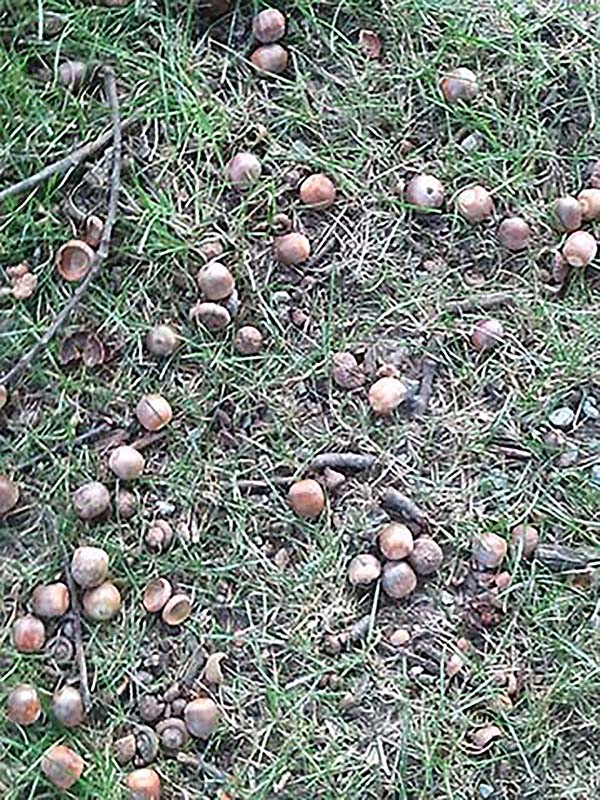
Figure 1. Northern red oak acorns cover the ground in a masting event.
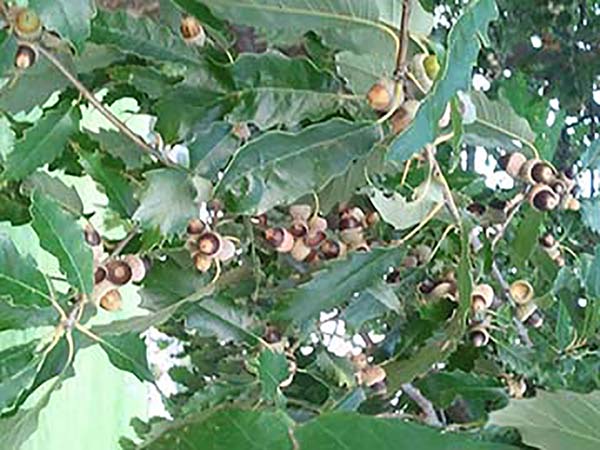
Figure 2. Chinkapin oak acorns clustered on branches.
Forgey Farm Field Day a Big Success
On September 25, 2014, over 100 people gathered at the Forgey property in Rush County, Indiana to enjoy a fine day full of presentations and tours demonstrating how tree plantings and wildlife habitat improvement practices can be used to provide benefits to landowners and their communities. Mike Forgey and his son Aaron served as hosts for the program, which highlighted the research plantings installed by the HTIRC over a period of several years, as well as a large Conservation Reserve Program tree planting and quail habitat improvement planting in an otherwise row-crop dominated landscape. Mike and Aaron, a graduate of the Purdue Department of Forestry and Natural Resources, approached the HTIRC five years ago to explore the possibility of cooperating with HTIRC by providing land and management assistance for research plantings covering several fine hardwoods like black walnut, butternut, chestnut, black cherry, and red and white oak. That partnership has extended to Aaron starting a business, named Legacy Hardwoods that will license and sell some of the superior selections of fine hardwood trees being developed by the HTIRC.
An article on the program appeared in September 2014 Farm Indiana magazine on page 34 and 35. http://issuu.com/screamingeaglemedia/docs/septfarm/1
This program was the result of a successful partnership between local entities like the USDA Farm Service Agency, and Natural Resources Conservation Service, Purdue University Forestry and Natural Resources – HTIRC, Purdue Extension, IN Department of Natural Resources, and Rush & Fayette County Soil and Water Conservation Districts, and our hosts, the Forgey Family Farm. Our thanks to all for the hard work provided by the partners to make this event a success. We look forward to repeating this program in the future to follow the progress of the plantings.

Figure 1. Mike and Aaron Forgey welcome participants to the program and
provide a summary of the history of their farm and partnership with HTIRC.

Figure 2. Purdue wildlife specialist Rob Chapman discusses the
quail habitat area with high school students attending the field day.

Figure 3. Aaron Forgey and Keith Woeste, HTIRC molecular geneticist,
discuss black walnut plantings with participants.

Figure 4. Brian Beheler and Don Carlson, Purdue foresters,
demonstrate the
use of plastic mesh fence to protect tree plantings from deer browse damage.
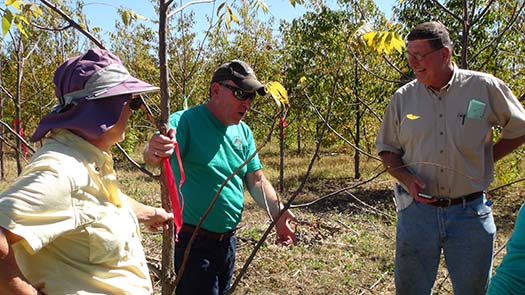
Figure 5. Mike Forgey shares some details on
the tree plantations with particpants.
HTIRC Hosts 2nd Restoring Forests Congress
Between October 14 and 16 the HTIRC hosted 114 attendees from 16 countries and 15 US states for the 2nd Restoring Forests Congress. The theme for the congress was Restoring Forests: What constitutes success in the 21st century? This international gathering of forest restoration and regeneration researchers provided a unique opportunity to share cutting-edge research, discuss innovative approaches to forest restoration issues, and communicate with colleagues from around the world. Eight invited speakers headlined each topical session, which also included 48 oral presentations and 28 posters. October 16th included an afternoon tour of HTIRC research sites at the Martell Forest. HTIRC scientists and graduate students provided explanations of research work at several stations around the property.
To see the scope of presenters and topics, you can visit the following website: https://www.purdue.edu/fnrrf/
The organizing committee for the congress:
Douglass F. Jacobs. Purdue University, HTIRC (USA)
Juan A. Oliet. Universidad Politécnica de Madrid (Spain)
Charles H. Michler. USDA Forest Service, HTIRC (USA)
Robert D. Mangold. USDA Forest Service (USA)
Liz Jackson. Purdue University, HTIRC (USA)
Sponsors for the event included the USDA Forest Service, USDA Forest Service Northern Research Station, USDA Forest Service Pacific Northwest Research Station, Hardwood Tree Improvement & Regeneration Center, and Purdue University Department of Forestry & Natural Resources.

Figure 1. Partipants gather prior to the field tour of HTIRC
research sites at Martell Forest.
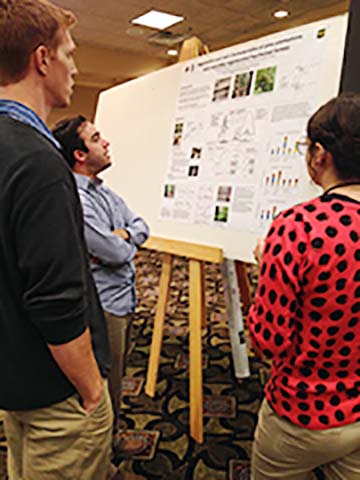
Figure 2. HTIRC students participate in the poster session of the congress.
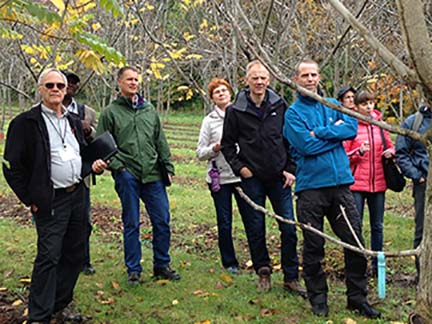
Figure 3. Congress participants tour the walnut collection planting of several
walnut and butternut species and hybrids.
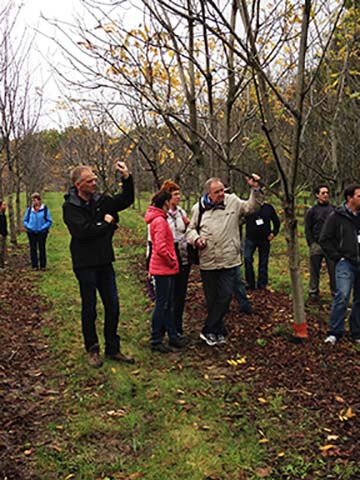
Figure 4. HTIRC staff and congress participants discuss the
research projects visited during the field tour.
HTIRC Participates in the Largest Forestry Conference in Decades
Over 4000 forestry professionals gathered in Salt Lake City this October to participate in the combined conferences of the Canadian Institute of Forestry/l’Institut forestier du Canada, Society of American Foresters, and the International Union of Forest Research Organizations. This combined event represented the largest gathering of forest managers and researchers in decades and perhaps the largest in history. Over 100 countries were represented at the conference. The HTIRC and Purdue University Department of Forestry and Natural Resources partnered to provide a booth in the exhibit hall to engage alumni, potential graduate students, and event attendees. HTIRC and Purdue FNR staff manned the booth and enjoyed the opportunity to interact with foresters from around the country and world. In addition faculty and students provided several research presentations and posters as a part of the scientific program of the conference.
HTIRC Partners Support Research with Matching Funds
One of the strengths of the HTIRC are the many partners who provide input, feedback, and significant support to the research programs. We are grateful to all our partners and sponsors for their contributions to help us work on important issues in forest management and tree improvement.
The Indiana Hardwood Lumbermen’s Association (IHLA) and Pike Lumber Company are currently providing matching funds to encourage other IHLA members to donate to the HTIRC to advance research on Thousand Cankers Disease.
We thank these partners for their support of efforts to better understand and combat this threat to the black walnut resource.
Purdue Forestry Farm Named for Former Senator Richard G. Lugar
Purdue’s forestry and natural resources farm has been renamed the Richard G. Lugar Forestry Farm. The 175-acre forestry farm promotes production of improved hardwoods to benefit Indiana’s forest products industry. In addition, students use the farm’s resources for their research, and the farm is the site of numerous Extension programs. It operates primarily under the auspices of Purdue Hardwood Tree Improvement and Regeneration Center, which Lugar helped to create. “Senator Lugar has a passion for trees, a passion for science and a passion for Purdue,” said Forestry and Natural Resources head Rob Swihart. “It is an entirely fitting tribute to have the property that promotes forest science named in his honor.” Senator Lugar visited the campus on November 11 for the dedication ceremony, and later gave a talk on global food security.
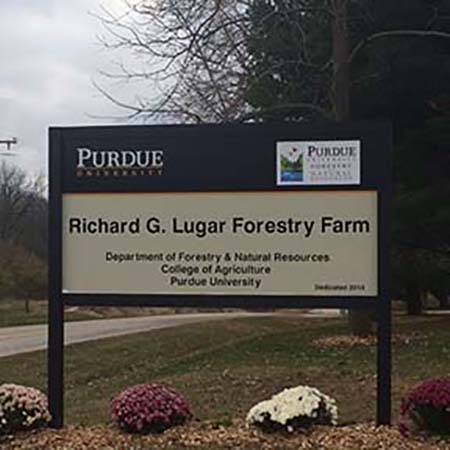
Have questions about tree planting? This series of publications can be viewed or downloaded free of charge. Planting and Care of Fine Hardwood Seedlings
van Eck Scholarships available for graduate research with the HTIRC.
Ask the HTIRC: email Lenny Farlee with your tree planting and forest management questions and we’ll help you find the answers.

